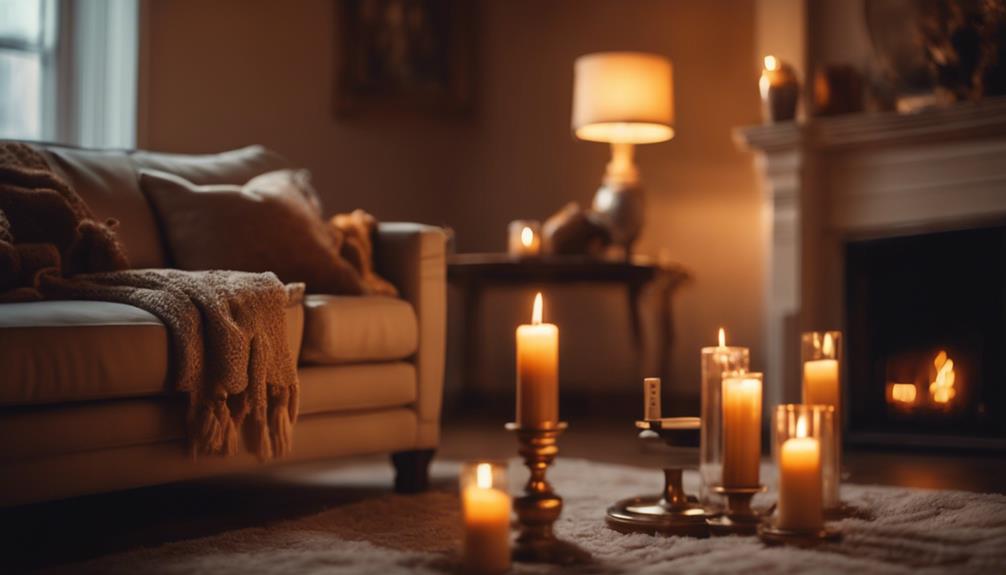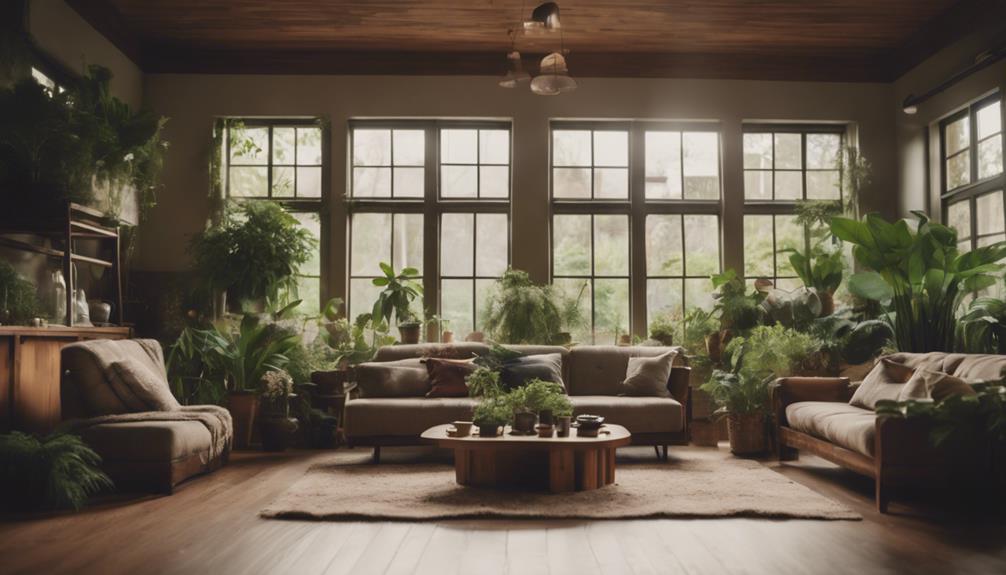Perfect lighting can completely change the feel of any room, enhancing your mood and boosting well-being. Use a combination of general, task, and accent lighting to layer your space effectively. Warm tones create a cozy atmosphere for relaxation, while cooler tones energize work areas. Pay attention to natural light, adjusting your fixtures to maximize it. Don't forget about the science of light temperature; experimenting with different Kelvin levels can refine your ambiance. By exploring various techniques, you can truly elevate your home. Discover how to make the most of your lighting choices for impressive results!
Key Takeaways
- Strategic lighting shapes mood and behavior, enhancing emotional well-being and productivity in various environments.
- Layering ambient, task, and accent lighting creates a balanced atmosphere tailored to specific room needs.
- Choosing the right light temperature influences relaxation and productivity, with warm tones for cozy areas and cool tones for workspaces.
- Optimizing natural light and reflective decor can drastically improve room brightness and ambiance.
Understanding the Importance of Lighting
Lighting plays an essential role in shaping your mood and behavior, as it can enhance your emotional well-being and productivity throughout the day. When you expose yourself to natural light, you'll likely notice a boost in your energy levels and improved sleep quality. Studies show that access to daylight improves not only your mood but also your overall emotional state. So, whether you're working from home or unwinding after a long day, consider how lighting affects you.
Different types of light can create various atmospheres in your space. For instance, warm light can foster a cozy, relaxing environment, while cooler light can help you concentrate and stay alert. By strategically using lighting, you can reduce irritability and promote a sense of calmness or focus, depending on what you need at the moment.
Incorporating more natural light into your daily routine—such as sitting near a window or taking breaks outdoors—can greatly uplift your mood. Understanding the importance of lighting in your environment is vital to enhancing your well-being and maximizing your productivity, making it a key element in your daily life.
Types of Lighting Explained
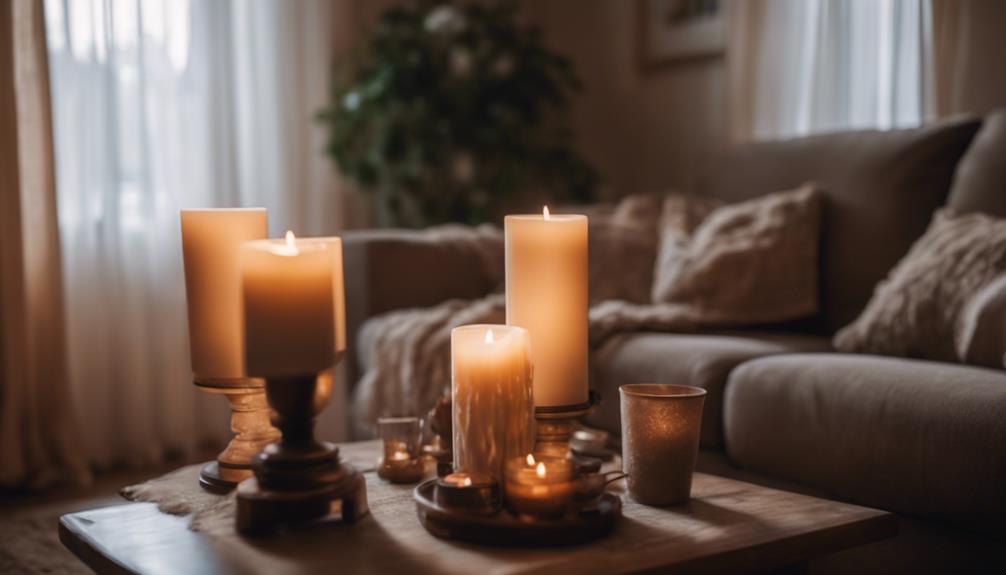
When it comes to lighting, understanding the difference between general and task lighting can transform your space.
You'll want to layer these types to create a balanced ambiance that suits your activities and mood.
Let's explore how combining these lighting styles can enhance both functionality and aesthetics in your home.
General Vs. Task Lighting
Understanding the difference between general and task lighting is essential for creating spaces that are both functional and inviting.
General lighting, often referred to as ambient lighting, provides overall illumination for a room, ensuring that you can see and move around safely. This type of lighting is typically achieved through lighting fixtures like ceiling lights or natural light streaming in from windows.
On the other hand, task lighting focuses on specific areas to assist with particular activities, such as reading, cooking, or working. With directed sources like desk lamps or under-cabinet lights, task lighting minimizes eye strain and enhances your ability to complete tasks efficiently.
Combining general and task lighting allows you to customize each room according to your needs. For example, a brightly lit workspace with effective task lighting can boost your mood and productivity, while a cozy living room may benefit from softer general lighting.
Layering for Ambiance
Creating a harmonious atmosphere in your space involves skillfully layering ambient, task, and accent lighting to enhance both functionality and aesthetics. This approach guarantees you've got the right lighting styles to suit any activity or mood.
Start with ambient lighting, which serves as the foundation of your room's brightness. Use fixtures like chandeliers or recessed lights to provide overall illumination.
Next, incorporate task lighting to focus on specific activities. Table lamps, under-cabinet lights, or even pendant lights can make tasks like reading or cooking easier and more enjoyable.
The Science of Light Temperature

When you think about light temperature, it's all about the Kelvin measurements that define how warm or cool your space feels.
Choosing between warm tones for coziness or cool tones for energy can greatly affect the ambiance and even how you perceive colors in your room.
Understanding these differences helps you create the perfect lighting to match your personal style and comfort.
Understanding Kelvin Measurements
Light temperature, measured in Kelvin (K), plays an essential role in shaping the atmosphere and mood of your spaces. Understanding color temperature helps you choose the right lighting for each room.
Lower values, typically between 2,000K and 3,500K, produce warm light that creates a cozy, inviting environment perfect for living rooms and bedrooms. This warm light encourages relaxation and comfort, making it ideal for unwinding after a long day.
On the other hand, higher Kelvin values, ranging from 4,500K to 6,500K, yield cool tones, which are bright and energizing. These cooler lights are well-suited for task-oriented areas like kitchens and offices, where clarity and focus are essential.
White tones, around 3,500K to 4,100K, provide a balance, offering clear visibility for spaces like bathrooms and kitchens, enhancing functionality.
Choosing the right light temperature based on your personal comfort can greatly enhance your well-being. Remember that individual responses to light vary, so experimenting with different Kelvin measurements can help you find the perfect ambiance for every room in your home.
Warm Vs. Cool Tones
Understanding the differences between warm and cool tones can help you choose the right lighting to enhance the mood and functionality of your spaces. The science of light temperature, measured in Kelvin, plays an essential role in how you feel in a room.
Here are three key points to reflect on:
- Warm Tones (2,000K – 3,500K): These create cozy atmospheres, perfect for relaxation in bedrooms and living areas. They promote a sense of comfort and are ideal for winding down.
- Cool Tones (4,500K – 6,500K): These provide bright, energizing environments suitable for workspaces and sunrooms. Exposure to cool light enhances alertness and focus, boosting productivity during the day.
- Mood Impact: Your choice between warm and cool tones can greatly influence your mood. Warm light is great for evenings, helping you relax, while cool light is beneficial for daytime tasks.
Ambiance and Color Perception
The color temperature of your lighting directly impacts how you perceive colors and textures in your space, shaping the overall ambiance and mood.
Light sources emit varying color temperatures, measured in Kelvin (K), affecting how you experience your environment. For instance, warm tones (2,000K-3,500K) create cozy atmospheres, perfect for relaxation in bedrooms and living areas. In contrast, white tones (3,500K-4,100K) offer clear visibility, making them ideal for functional areas like kitchens and bathrooms.
Cool tones (4,500K-6,500K) are bright and energizing, boosting focus and productivity in workspaces and sunrooms. These different color temperatures can alter your perception of colors and textures, enhancing or diminishing the beauty of your decor. Natural sunlight, typically around 5,000K, provides a balanced reference point for color perception, making it an excellent choice when you're looking to replicate that effect indoors.
When selecting lighting, consider your personal preferences and the desired ambiance for each space. Choosing the right color temperature not only elevates the mood but also enhances your emotional well-being, making your home a more inviting sanctuary.
Layering Light for Ambiance
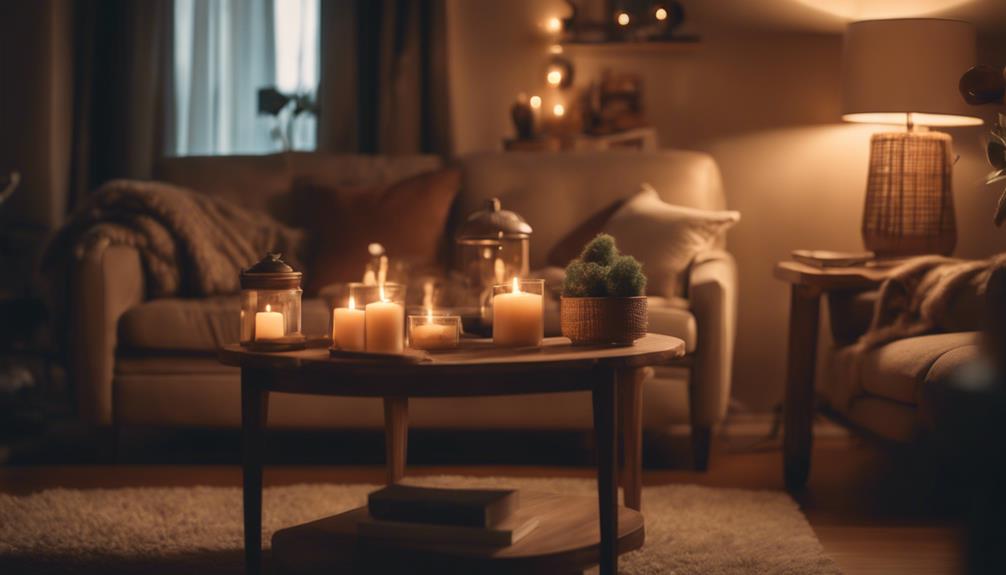
Layering light creates a harmonious blend of ambient, task, and accent lighting that transforms any space into a visually appealing and functional environment. To achieve effective layering, consider these three essential elements:
- Ambient Lighting: This is your base layer, providing general illumination. Think ceiling fixtures and wall sconces that fill the room with light.
- Task Lighting: Focus on specific areas where you need extra brightness. Desk lamps or under-cabinet lights in the kitchen are perfect examples, ensuring you can perform activities comfortably.
- Accent Lighting: Highlight architectural features or artwork with spotlights or decorative lamps, adding depth and interest to your space.
Utilizing dimmable fixtures can greatly enhance this layering, allowing you to adjust brightness levels for different moods and activities.
Additionally, pay attention to light temperature; warm tones create a relaxing atmosphere, while cool tones boost productivity.
By mastering layering light, you not only improve the usability of your rooms but also enhance emotional well-being, creating spaces that feel inviting and comfortable.
Embrace this technique, and you'll be amazed at how it elevates your home!
Room-Specific Lighting Techniques
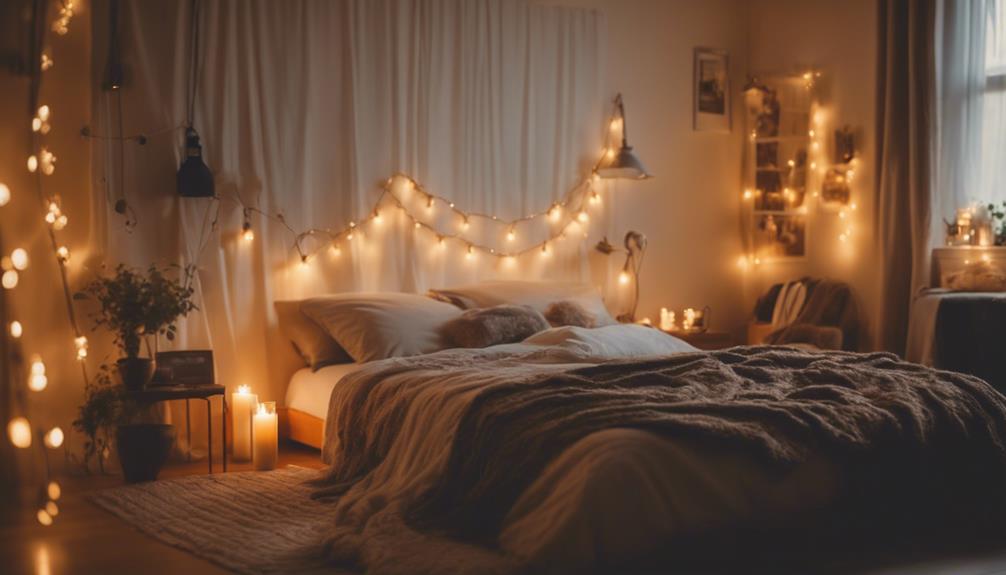
Choosing the right lighting for each room can greatly enhance both functionality and mood, making your home more inviting and comfortable. You can utilize room-specific lighting techniques to achieve the perfect atmosphere.
In bedrooms, opt for a mix of general, task, and accent lighting with warm tones (2,000K-3,500K) to promote relaxation and restful sleep.
For bathrooms, verify you have bright lighting, at least 60 watts, with warm hues to provide accurate reflections and minimize shadows around vanities.
In kitchens, bright, even lighting with white tones (3,500K-4,100K) is essential for clarity and safety during food prep; under-cabinet lights can serve specific tasks effectively.
In living rooms, layer your lighting by combining warm and cool tones for a cozy yet vibrant ambiance, using accent lights to showcase art or architectural features.
Finally, maximize natural light in your home office, supplemented by LED task lighting to boost productivity. Avoid bright lights at night to maintain your sleep cycle.
Common Lighting Mistakes to Avoid

Avoiding common lighting mistakes is crucial to creating a welcoming and functional atmosphere in your home. Here are three key errors to steer clear of:
- Over-reliance on a single lighting layer: Using only ambient lighting can lead to inadequate illumination. A balanced lighting plan should include task and accent lighting to enhance the space.
- Neglecting natural light: Failing to optimize natural light sources can make your rooms feel dark and uninviting. Position mirrors or light-colored decor to reflect sunlight and brighten your space.
- Ignoring color temperature: Not considering color temperature can upset the mood of a room. For example, using cool, bright tones in a relaxing area can increase stress. Choose warm light for cozy environments and cooler tones for workspaces that require focus.
Additionally, verify you incorporate flexibility in lighting arrangements. Using dimmers or adjustable fixtures allows you to adapt the brightness according to the time of day or the activity at hand.
Collaborating With Lighting Experts
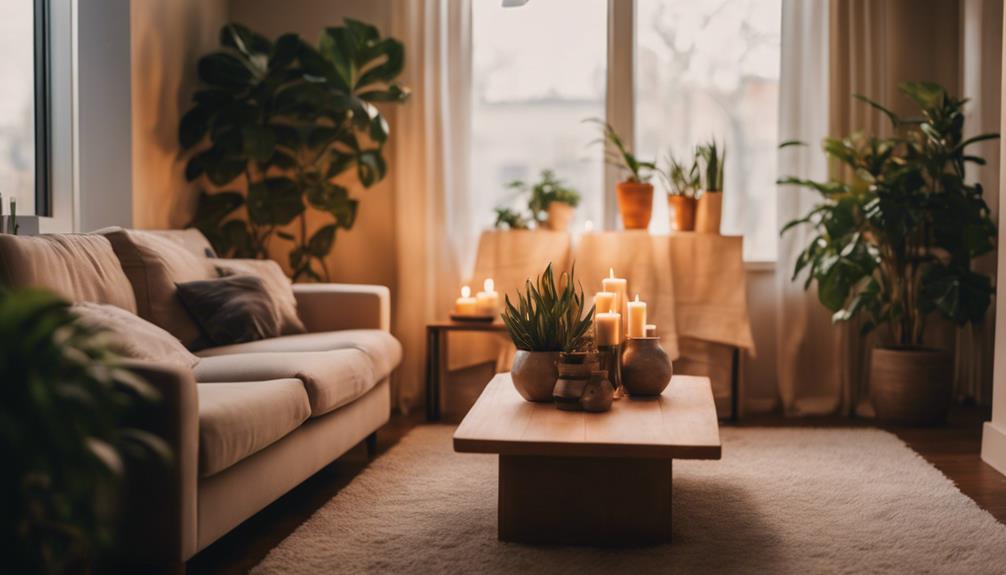
Working with lighting experts can elevate your home's atmosphere by delivering tailored solutions that blend functionality and style.
Lighting specialists assess your unique needs and desired ambiance, ensuring you get the right mix of ambient, task, and accent lighting. They understand how different light temperatures affect the mood and can recommend fixtures that enhance your space beautifully.
When you collaborate with these professionals, they'll help you avoid common design pitfalls. They guide you in maximizing natural light and suggest additional sources to compensate for any deficiencies. This not only enhances your room's look but also promotes mental well-being and alertness.
Engaging lighting experts provides you with customized plans that consider your space's unique features and your personal preferences. They offer insights into the latest technologies and smart controls to improve energy efficiency, making your lighting solutions both stylish and sustainable.
Conclusion
Incorporating the perfect lighting can transform your space like a painter adding the final brushstrokes to a masterpiece.
By understanding the importance of light, exploring various types, and avoiding common mistakes, you can create an inviting ambiance that reflects your style.
Don't hesitate to collaborate with lighting experts for that extra touch of magic.
Remember, the right lighting doesn't just brighten a room; it elevates your mood and enhances every moment spent within those walls. For example, selecting warm, soft lighting can create a cozy and inviting atmosphere, perfect for unwinding after a long day. Additionally, using dimmer switches allows you to adjust the lighting to fit different activities and moods throughout the day. By following these perfect mood lighting tips, you can transform any room into a tranquil and welcoming space for yourself and your guests to enjoy.
